
FUNAI Misa Solo Exhibition “Paradise / Boundary, where we were once”
10:00am - 6:00pm, July 25 –September 10, 2017 / Admission Free
air2017-3en
FUNAI Misa

Mountain / Mother
2014
Hole / Trans rabbit
2014
Hole / Flower snake
2014
Hippocampus
2014
photo: KIOKU Keizo
Paradise of the Beginnings: Child as a Guide
KANEKO Yukiko
FUNAI Misa’s means of expression have been changing greatly from the earliest stage, when she produced improvised drawings on canvas, to her mural paintings presented at Aomori Contemporary Art Centre in 2007, and the works composed of images with mirror surfaces that are still being produced, as well as three-dimensional works that she positions as “painting to ride.”(*1) Despite those changes, her thought to pursue expressions in painting is always consistent. In this exhibition, major works by Funai from the early stage up to the present are assembled to overview the changes in the means of expression that she has pioneered and her consistent thinking. Here I look back on my experience of arranging the entire exhibition as an installation through the interaction between the works and the specific space of ACAC, a huge half-arc gallery without any partition.
Placed in the center are works of a series of “painting to ride” including Mountain/Mother, her largest slide-type work that is 4m wide, 10m deep and 5m high. They are like playground toys, and visitors are welcome to play there to be part of the work. On either side of those works, the mirror works Hole/Paradise/Boundary/Painting/Fundus of the Eye and Cave/Explosion are placed on the extreme ends of the arc facing each other, and the drawings are placed on the walls between the mirror works and the three-dimensional work. In the gallery formed as described above, the viewer is expected to proceed along the huge curved corridor. While looking at people playing in the center of the space out of the corner of their eyes, the viewer takes a look at the drawing on canvas, and recognizes that the plane surface and the three-dimensional are mixed together with the gallery space and people reflected in the flat mirror. When reaching the three-dimensional work, the viewer is taken into part of the work before they know it, and become those who are seen in reverse. As they pass the three-dimensional work, they again gaze at the images of the imaginary and the real fused in the mirrors, and return to the drawings beyond them. Displayed in the small room space where the right half of the innermost part is partitioned are her drawings from the earliest stage and her study Medium that she is still drawing like a diary while “exploring the deep psyche in the unconscious bottom.”(*2)
In a cave where mural paintings were drawn in the late period of the Old Stone Age including Lascaux, the very experience of entering the dark and small cave was necessary for accessing the mysterious area to reach the psychological depths accompanied by a trance state and hallucination. Moreover, the production of images for a mural is said to have created a new spiritual world.(*3) In the installation of this exhibition, the viewer proceeds into the interior while experiencing the crossover of the two-dimensional and the three-dimensional, as well as the transformation from a viewer to a person viewed, and the fusion of the imaginary and the real, to reach the deepest part of the gallery where her initial drawings which support the foundation of her creation and the drawings that she works on every day. Likened to the above mural painting in a cave, this installation is a path to reach the depths of the artist’s heart, and that leads the viewers to look into the depths of their own minds by way of the internal and external change through the work, and to discover another world, that is, a paradise, in the work.
Also in her drawing, Funai is conscious of swaying between material and non-material, and I would say that the transition from drawing to a three-dimensional work means more clearly shifting images in the painting from non-material to material. How a flat plane and a solid object intersect in a space seems to transform an image popping out from the two dimensions into a three-dimensional object. If so, a person invited as part of the work in a three-dimensional work is also an image jumping out of the drawing to be made into a substance. By going back and forth between the drawing and the three-dimensional work, a person as a materialized image experiences mentally as the subject traveling between here and there, that is to say, the two dimensions and the three dimensions, and the real space and the painting space. As the object, that person exists in the image as an entity on the boundary coming and going between the two.
While inviting viewers to her imaginary world, Funai particularly focuses on the existence of children. Children treating equivalently mental phenomena, such as reality and fantasy, consciousness and unconsciousness, and sleeping and awakening, (*4) go between here and there more powerfully than adults. MURASE Manabu interprets this equivalence as follows.
“It is similar to the mentality of saints invariably inviting all people, bad or good, healthy or sick, to treat in the same way.” (*5) It means that a child is depicted in her work as a person on the boundary going back and forth between here and there, and at the same time, that child is summoned as a person who treats equivalently the whole of creation in which concrete shapes that Funai draws, such as animals, plants, landscapes, parts of the human body and the internal organs, coexist with forms resulting accidently from a series of organic lines and stains of ink. Furthermore, Murase thinks that because the repeatable “beginnings,” such as starting over, changing one’s mind and awakening, are early stages of the mental phenomena of people, and these “beginnings” are related to the fact that myths and religions of various countries and ethnic groups have stories of the creation of heaven and earth. He also points out that knowing the “beginnings” through the art of equivalency leads to the creation of a new world.(*6) In Funai’s work, therefore, a child is a guide who leads us to a paradise of the beginnings, encouraging us to be creative while integrating in-between the external/internal incorporated in her work.
Like people repeating the “beginnings,” Funai repeatedly draws paradise. The “beginnings” are linked to paradise, and the “beginnings” urge creation. The paradise depicted repeatedly by Funai makes us become aware of the “beginnings” and encourages us to head toward a new world.
______________________________________
*1 Taken from Funai’s interview in AC2, No. 19, Aomori Contemporary Art Centre, 2018.
*2 Explanations on Medium, distributed at the exhibition site.
*3 David Lewis-Williams, The Mind in the Cave, trans. Chihiro Minato (Tokyo: Kodan-sha, 2012), 370-1.
*4 Manabu Murase, Shoki Shinteki Gensho no Sekai—Rikai no Okure no Honshitsu wo Kangaeru, (Tokyo: Yamato Shobo, 1981), 73.
*5 Ibid., 73.
*6 Ibid., 70-6. Murase further points out that “Infantility in mental phenomena is not a passed stage of development. It is still alive in a living structure in us, in adults’ mental phenomena.” (p. 72)
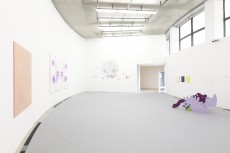

Hole / Paradise / Border / Painting / Fundus of the Eye
2010
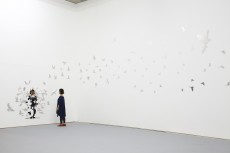
Cave / Explosion
2014
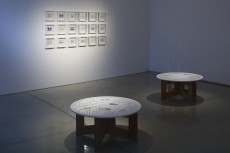
Medium
2011-2017
(above all)photo: KIOKU Keizo
船井美佐展 楽園/境界 〜いつかいた場所〜
2017年7月25日(火)-9月10日(日)10:00-18:00 会期中無休/無料
船井美佐
FUNAI Misa
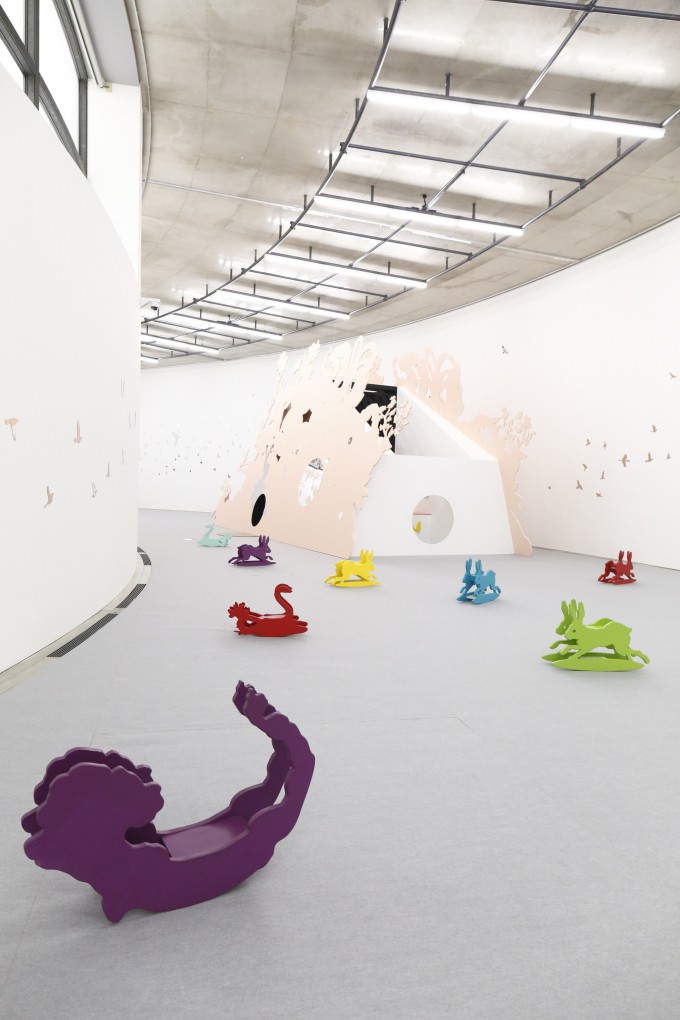
《Mountain / Mother》
2014年
《Hole / Trans rabbit》
2014年
《Hole / Flower snake》
2014年
《Kaiba》
2014年
撮影:木奥恵三
はじまりの楽園、導きの子供
金子由紀子
キャンバスに即興でドローイングを描いていた最初期から、2007年に国際芸術センター青森(ACAC)で発表した壁画、そして現在も制作を続ける鏡を切り取った面でイメージを構成する作品や本人が「乗れる絵画[1]と位置付ける立体作品と、船井美佐の表現手段は大きく変化してきたが、そこには一貫して絵画表現を追求する思考が伴う。本展では、初期からこれまでの船井の作品を一堂に会し、その表現手段を開拓してきた変遷と、一貫した思考を概観することを試みた。巨大な半弧形でパーテーションが無いひとつながりのギャラリーというACACの特殊な空間との相互作用による、展覧会全体でひと纏まりのインスタレーションとしての体験を振り返る。
ギャラリーでは約幅4m×奥行10m×高さ5mの船井作品の中で最大のすべり台型の作品《Mountain/Mother》を始めとした「乗れる絵画」シリーズの作品群が中央に置かれた。それらは立体の遊具型でそこで遊ぶことが歓迎されており、遊ぶ人は作品の一部へと取り込まれる。それを挟んで弧形の両端に向き合う形で鏡の作品《Hole/桃源郷/境界/絵画/眼底》と《Cave/Explosion》が設置され、鏡の作品と立体作品の間にドローイングが設置された。前述のような形のギャラリー内で鑑賞者は、巨大な廊下をカーブに沿うように奥に進むこととなる。空間の中央で遊ぶ人々を目の端に捉えながらキャンバスに描かれたドローイングを見、そのうちにギャラリー空間と人々が平面である鏡の中に映り込み、平面と立体が混ざり合う様を見る。それから立体作品にたどり着くといつの間にか作品の一部へ取り込まれており、見られる者へと反転する。そして立体作品を通り過ぎるとまた鏡の中に虚と実が混じり合うイメージを見つめ、その更に奥でドローイングへと還ってゆく。最奥部の右半分が仕切られ小部屋となったスペースには、最初期のドローイングと、船井が「無意識の底の深層心理を探索」[2]しながら日記のように描き続けている習作《Medium》が置かれた。
ラスコーを始めとする後期旧石器時代に壁画が描かれた洞窟では、暗く狭い洞窟内に入るという体験そのものがトランス経験や幻覚を伴って心理的深層部に到達させ神秘的な領域にアクセスするために必要な行為であり、加えて壁画というイメージの制作は新たな(霊的)世界を生み出すものでもあったという[3]。これになぞらえると、平面と立体の交差、見る者から見られる者への変容、虚と実の融合などを体験しながら奥に進み、最奥部に制作の根底を支える最初期のドローイングと日々描き続けるドローイングにたどり着くという本展のインスタレーションは、船井の心の深層部へ到達する道のりであり、鑑賞者が作品を通して自らの内的/形式的変容を経て心の深淵を覗き込み作品の中にもう一つの世界=楽園を見出すことにもつらなる。
ドローイングにおいても船井は物質と非物質の行き来に自覚的だが、ドローイングから立体作品への移行は、絵画の中のイメージをより明快に非物質から物質へと引き寄せることと言える。一つの空間で平面と立体が交差している様は、平面から飛び出したイメージが立体として物質化しているようにも見える。であるならば、立体作品において作品の一部として誘われる人もまた、ドローイングから飛び出し物質化したイメージである。物質化したイメージとしての人はドローイングと立体作品を往還することで、主体としては二次元と三次元、現実空間と絵画空間といったあちらとこちらの往還を心的に体験しながら、客体としては往還する境界者としてイメージの中に存在する。
鑑賞者を自らのイメージの世界へ誘う中で船井は特に、子供の存在に注目する。現実と空想、意識と無意識、眠りと目覚めなど様々な心的現象を等価に扱う子供[4]は、大人よりももっと力強くあちらとこちらを行き来する。村瀬学はこの等価性を「聖人が、悪人も善人も健康も病人も等しく招きよせて同じように対処したといわれる《心性》に似ている。」[5]とする。すなわち、船井の作品で子供は、あちらとこちらを行き来する境界者であると共に、船井が描く動物、植物、風景、人体の一部や内臓といった具象の形と有機的な線やインクの染みの連なりから偶然生まれる形が共存する森羅万象を等価に扱う者としても召喚されている。更に村瀬は、出直しや心機一転、目覚めといった反復可能な「はじまり」が人の心的現象の初期であり、この「はじまり」は様々な国や民族の神話や宗教が天地創造の話を持っていることとも関連するとした上で、等価の技で「はじまり」を知ることが新しい世界の創造へとつながるとする[6]。であるならば、船井の作品において子供は、作品に内包される形式的/心的なあちらとこちらを統べると共に、はじまりの世界としてある楽園へと導き、創造を促す先導者である。
人が「はじまり」を繰り返すように、船井は楽園を繰り返し描く。「はじまりが楽園へとつらなり、「はじまりが創造を促す。繰り返し描かれる船井の楽園は、我々に「はじまり」を自覚させ、新しい世界に向かうよう勇気づける。
__________________________
[1]船井美佐へのインタビューより。『AC2』19号、国際芸術センター青森、2018年。
[2]展覧会場での配布資料の船井による解説より。
[3] デヴィッド・ルイス=ウィリアムズ『洞窟のなかの心』港千尋訳、講談社、2012年、370–371頁。
[4] 村瀬学『初期心的現象の世界-理解のおくれの本質を考える』大和書房、1981年、73頁。
[5] 同上、73頁。
[6] 同上、70–76頁。更に村瀬は「心的現象にとっての幼児性とは、決して過ぎた発達段階のものではなく、今もなお私たちの大人の心的現象そのものの中に生きづいているひとつの生ける構造としてある」(同72頁)とする。
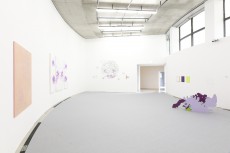
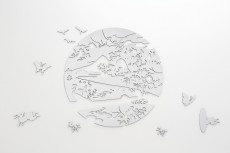
《Hole/桃源郷/境界/絵画/眼底》
2010年

《Cave / Explosion》
2014年

《Medium》
2011-2017年
(以上全て)撮影:木奥恵三
